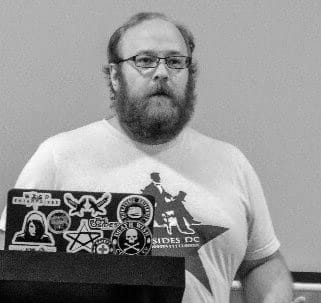Brink and You'll Miss It
Share this entry
An Examination of “World on the Brink: How America Can Beat China in the Race for the Twenty-First Century”
It is 2024 and, looming perhaps larger than any other truth in the technology landscape, we must come to terms with the fact that technology is political. A more relevant follow-on here is that security is political, as well. We cannot divorce the tool from the investigation or the result; they all exist in a shared ecosystem. Given that interdependence, it is incumbent upon security practitioners, companies, and institutions to lean in and be as informed as possible about the geopolitical landscape in which we operate, like any other intersection of protocols, technologies, humans, and risks we encounter elsewhere. In other words – a domain.
It’s in this context that I celebrated the announcement that Dmitri Alperovitch was writing, with Garrett M. Graff, a book entitled “World on the Brink: How America Can Beat China in the Race for the Twenty-First Century.”
Alperovitch co-founded behemoth cybersecurity company Crowdstrike and served as its Chief Technology Officer before moving on to found and chair the geopolitics think-tank Silverado Policy Accelerator. As someone far too Extremely Online, I’ve followed Alperovitch for years – a fantastic Twitter/X commentator in its heyday, and a self-described fellow “News Junkie.” He brings both deep experience and almost unparalleled inquisitiveness into my timeline regularly, especially regarding a region of the world about which I knew little. Alongside those and other qualities, Alperovitch also exhibits an absolutely necessary, but far too rare trait in policy wonks: the pressing need to measure and evaluate practical impact of policy and technology as a crucial step of the work. Policy as reality; not as thought experiment, draft, and release, but as ongoing practice.
Yeah, you can say I’m a fan. I’m also a politics and news junkie – Extremely Online, as noted, and a voracious reader. I’ve also had the honor of working for a technology contractor in the U.S. House of Representatives in Washington D.C. several jobs ago, spending my entire day pounding the marble in and out of House offices. As a lifelong politico, that was an amazing and eye-opening experience.
So when a book on one of the most important geopolitical questions of this century came out from him and former Politico editor and journalist Garrett M. Graff, I poured through it with a swiftness limited only by my competing need to, you know, fulfill my Security Operations duties and be coherent during the working day.
“World on the Brink: How America Can Beat China in the Race for the Twenty-First Century” – hereafter referred to as Brink, for brevity – is an excellent and relevant cross-disciplinary read. At 401 pages it is inclusive but not exhaustive, and holds important insights for not just politically- and technically-inclined readers but anyone looking to wrap their heads around the complex problems the United States faces regarding both China and Russia. But as hinted at above, Alperovitch’s history at Crowdstrike and earlier informs a unique and critical angle-of-attack on the problems: he makes clear the need to learn about, interact with, and understand the people and human dynamics involved rather than treating policy prescription as a dry exercise. As someone who came into security from user support, and consequently weights human factors very heavily, this speaks truth to me.
Folks familiar with Crowdstrike know just how good they are at profiling threat groups, going beyond immediate techniques and into actually understanding the adversary. “This wasn’t,” Alperovitch writes of his Crowdstrike learning, “…about learning how to block a particular email in an inbox – there were people on the other side learning from each of our moves. We evolved. They adapted to our countermeasures. I realized that collecting intelligence and understanding what an adversary’s motivations are and where they’re headed is fundamental to cybersecurity.” He continues:
The question wasn’t how you stop the Night Dragon hackers from compromising your system; the challenge for the US government was “How do we stop China?” For that, there were both technical and nontechnical solutions.
Brink echoes this important approach for the China problem in our national and global contexts. By skillfully calling upon history from the Qing Dynasty to the Boxer Rebellion to Chiang Kai-shek and the KMT, Alperovitch and Graff build a foundation on which to understand China as world-stage actor and adversary in a way often missed by the sound byte diplomacy we’re used to seeing today. The reader is encouraged and informed to see things from foreign points of view in a deep and satisfying way that doesn’t demonize our ostensible adversaries nor toxically lionize ourselves.
There are significant challenges to overcome in Brink’s first goal: building a better foundation for understanding the adversary, before later proposing strategies informed by this foundation. We can fall back upon CIA veteran Richards Heuer’s “Psychology of Intelligence Analysis” and its excellent discussion of how inherent biases interfere with effective intelligence work and, subsequently, policy formation and deployment. For the sake of time I’ll restrict scope here to Heuer’s four Principles of Perception:
- “We tend to perceive what we expect to perceive.”
- “Mindsets tend to be quick to form but resistant to change.”
- “New information is assimilated to existing images.”
- “Initial exposure to blurred or ambiguous stimuli interferes with accurate perception even after more and better information becomes available.”
There are few situations, scenarios, and landscapes more fraught with pre-existing expectations, perceptions, and images than the relationship between hyperpowers like the United States of America and China. Quite naturally, this set of challenges extends to forming coherent and effective policy. And while my own political positions are rightly outside the scope of this blog post, I admit to finding myself exquisitely challenged at some points both in my pre-existing biases and what policies would truly be effective. Given the path painstakingly trailblazed and then charted in Brink, I expect most people will find themselves challenged at different points in the book. This is probably a reliable sign that Alperovitch and Graff have done well.
One of the many lessons I learned from former Farsight Chief Technology Officer and Former DomainTools Chief Architect Ben April, now CTO of partner Maltego, is to pay attention to maps whenever they’re made apparent. Brink capitalized on this lesson for me in both geographic and economic ways across the text:
Maps are stories – what you choose to feature, how you orient it, the scale – every choice that goes into making a map is an editorial decision that changes what the map conveys, who it is important and useful to, and whose narrative or history it tells.
From there, Brink provides not just carefully curated maps to tell the stories involved – the human narratives – but further jumping-off points for the reader to investigate themselves and understand better not just the end-narrative but its very formation across decades in the minds of those we seek to understand as actors, threat actors, and adversaries. The book does this in the context of not only China but also Russia’s invasion of Ukraine and the challenges that Russia presents in active, practical terms; lessons, some of which we can extrapolate and apply to China as well.
Once it moves from foundation-building to solution-engineering as policy practice, Brink not only provides policies to adopt but explains them in practical and optical terms from our end as well as how they will be seen from an adversarial viewpoint if sensibly deployed and well-maintained. These policies including preventing China from achieving “chip breakout” with self-sustaining advanced microchip fabrication, wideband export controls to ensure a certain level of fabrication and materials dependence, minding our own security by securing our own supply lines and processing capabilities, and the common-sense but critical step of institutions responsible for coordinating all measures as well as ongoing evaluation and adaptation to current and future needs.
I found myself simultaneously challenged and delighted in the way Brink excels at explaining American weaknesses and strengths, and highlights the need to reform industry and immigration regulatory processes both.
The third key ingredient in the recipe for enabling American innovation is people. Nothing happens without them. And America needs both more people and, specifically, more of the world’s best people. We need to shift our political thinking on immigration and approach the issue from a more strategic perspective.
There is no greater resource in America than its people, whether born here or having migrated, and Brink minces no words in describing the importance of re-establishing America as not only exceptional but welcoming, and especially welcoming of those looking to help solve exceptional or difficult problems, be they delicate fabrication processing or alleviating massive employment shortages in service sectors facing ever more daunting age and population demographic trends.
Smart, compassionate, enthusiastic immigration policy makes us a stronger, more innovative nation – I say this not just as a believer in the power of people, nor just as a security practitioner, but also as the son of an immigrant to the United States, barely one generation removed from a loving couple who ventured here to escape the crushing poverty of early twentieth century Canadian coal-mining.
Brink then pivots to how to defend what we have, or what we invent, from Chinese government-led intellectual property theft or unfair trade practices. Another strong argument from the authors is the need for a massively rejuvenated American defense industrial base, as informed by the lessons of Russia’s invasion of Ukraine and the practical realities of how quickly two developed nations ran through insufficient stockpiles of arms and technology, as well as interesting insights on hyper-expensive versus “disposable” weapons and platforms. Having the above experience in Congress, I cheered aloud as the book detailed political dysfunction and its consequences, such as repeated Continuing Resolutions instead of mature appropriations bills. And then appreciated the cogent points made as far as not fully decoupling from China – a foolish extremism – and the need to support and be supported by our dependable allies in all of this.
“World on the Brink: How America Can Beat China in the Race for the Twenty-First Century” by Dmitri Alperovitch and Garrett M. Graff provides a practical, ground-level, coherent and important commentary on viable paths forward as we make our way through the twenty-first century. That navigation has proven no less difficult than the previous turbulent hundred years, and with uniquely looming problems like climate change, instantaneous information systems, AI and its associated problems like being a force-multiplier for disinformation campaigns, we only have a harder road ahead. I may not agree with all points raised or strategies provided in their book, but Brink provides a great deal of detailed and rigorous foundational thinking for what could come next.
In much of the business of cybersecurity, as Alperovitch notes generally, “we do not have a cyber problem – we have a China, Russia, Iran, and North Korea problem.” A people problem. May we all approach it informed, reasonable, and ready to protect and enable people, government, and trade to new heights as we go forward.






